2018 TOYOTA PROACE VERSO belt
[x] Cancel search: beltPage 181 of 504

181
In line with European legislation, this table indicates the options for installing child seats secured using a seat belt and universally approved (a) for the weight of the child and the seat in the vehicle.
Seat
Weight of the child and indicative age
Under 13 kg (groups 0 (b) a n d 0 +)Up to approx 1 year
From 9 to 18 kg (group 1)1 to 3 years approx
From 15 to 25 kg (group 2)3 to 6 years approx
From 22 to 36 kg (group 3)6 to 10 years approx
Row 1 (c) (d)
With captain seat, passenger seatUUUU
With bench seat, outer seatUUUU
With bench seat, centre seatXXXX
Row 2 (e) (f)
Outer seatsUUUU
Centre seatUUUU
Row 3 (e) (f)
Outer seatsUUUU
Centre seatUUUU
Locations for child seats secured with a seat belt
5
Safety
Page 182 of 504
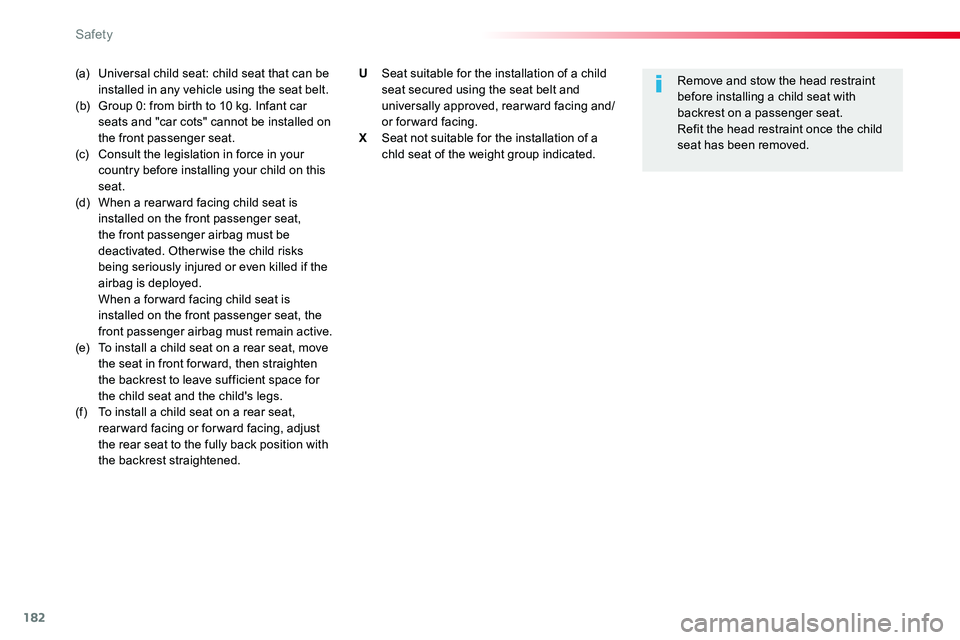
182
(a) Universal child seat: child seat that can be installed in any vehicle using the seat belt.(b) Group 0: from birth to 10 kg. Infant car seats and "car cots" cannot be installed on the front passenger seat.(c) Consult the legislation in force in your country before installing your child on this seat.(d) When a rear ward facing child seat is installed on the front passenger seat,
the front passenger airbag must be deactivated. Other wise the child risks being seriously injured or even killed if the airbag is deployed. When a for ward facing child seat is installed on the front passenger seat, the front passenger airbag must remain active.(e) To install a child seat on a rear seat, move the seat in front for ward, then straighten the backrest to leave sufficient space for the child seat and the child's legs.(f) To install a child seat on a rear seat, rear ward facing or for ward facing, adjust the rear seat to the fully back position with the backrest straightened.
Remove and stow the head restraint before installing a child seat with backrest on a passenger seat.Refit the head restraint once the child seat has been removed.
U Seat suitable for the installation of a child seat secured using the seat belt and universally approved, rear ward facing and/or forward facing.X Seat not suitable for the installation of a chld seat of the weight group indicated.
Safety
Page 184 of 504
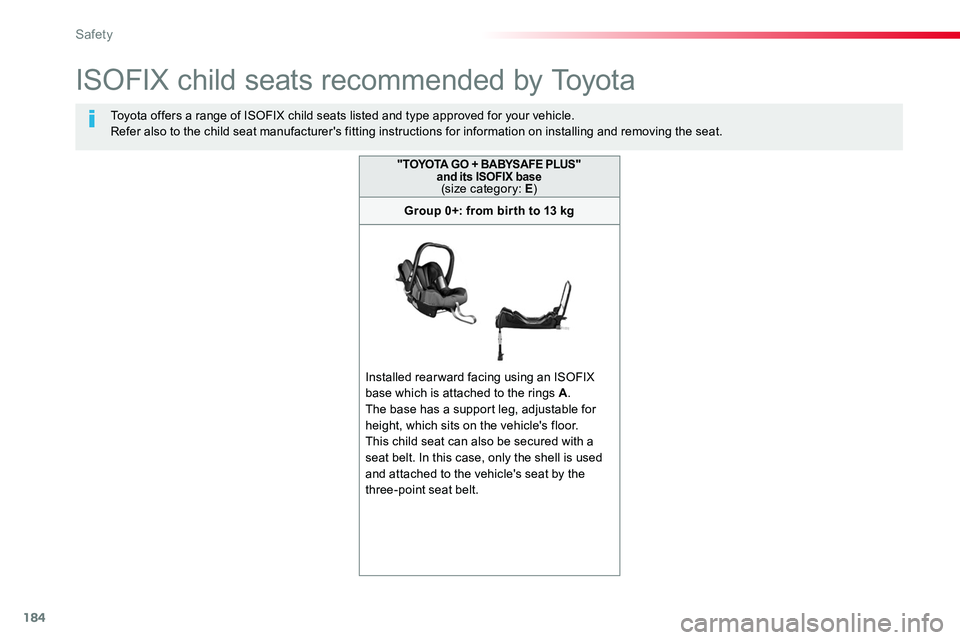
184
ISOFIX child seats recommended by Toyota
Toyota offers a range of ISOFIX child seats listed and type approved for your vehicle.Refer also to the child seat manufacturer's fitting instructions for information on installing and removing the seat.
"TOYOTA GO + BABYSAFE PLUS" and its ISOFIX base (size category: E)
Group 0+: from bir th to 13 kg
Installed rearward facing using an ISOFIX base which is attached to the rings A.The base has a support leg, adjustable for height, which sits on the vehicle's floor.This child seat can also be secured with a seat belt. In this case, only the shell is used and attached to the vehicle's seat by the three-point seat belt.
Safety
Page 185 of 504
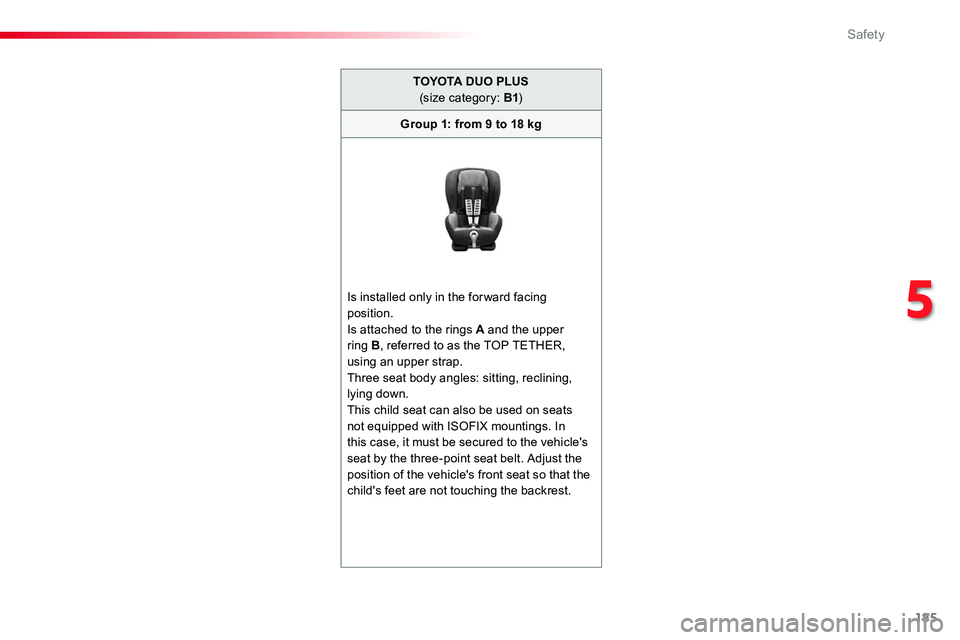
185
TOYOTA DUO PLUS (size category: B1)
Group 1: from 9 to 18 kg
Is installed only in the for ward facing position.Is attached to the rings A and the upper ring B, referred to as the TOP TETHER, using an upper strap.Three seat body angles: sitting, reclining, lying down.This child seat can also be used on seats not equipped with ISOFIX mountings. In this case, it must be secured to the vehicle's seat by the three-point seat belt. Adjust the position of the vehicle's front seat so that the child's feet are not touching the backrest.
5
Safety
Page 189 of 504
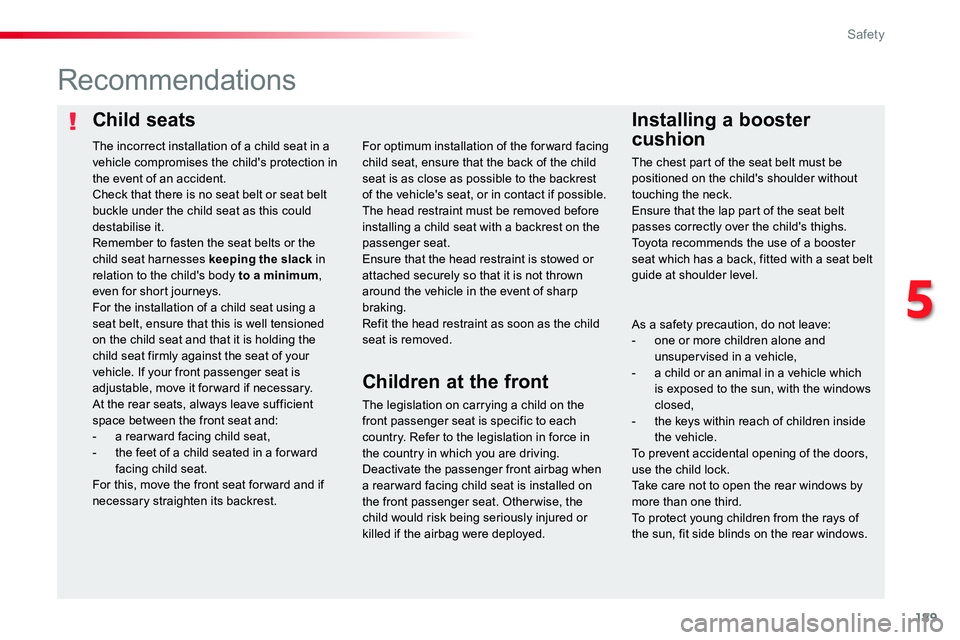
189
Child seatsInstalling a booster
cushion
Recommendations
The legislation on carrying a child on the front passenger seat is specific to each country. Refer to the legislation in force in the country in which you are driving.Deactivate the passenger front airbag when a rear ward facing child seat is installed on the front passenger seat. Otherwise, the child would risk being seriously injured or killed if the airbag were deployed.
For optimum installation of the forward facing child seat, ensure that the back of the child seat is as close as possible to the backrest of the vehicle's seat, or in contact if possible.The head restraint must be removed before installing a child seat with a backrest on the passenger seat.Ensure that the head restraint is stowed or attached securely so that it is not thrown around the vehicle in the event of sharp braking.Refit the head restraint as soon as the child seat is removed.
The incorrect installation of a child seat in a vehicle compromises the child's protection in the event of an accident.Check that there is no seat belt or seat belt buckle under the child seat as this could destabilise it.Remember to fasten the seat belts or the child seat harnesses keeping the slack in relation to the child's body to a minimum, even for short journeys.For the installation of a child seat using a seat belt, ensure that this is well tensioned on the child seat and that it is holding the child seat firmly against the seat of your vehicle. If your front passenger seat is adjustable, move it for ward if necessary.At the rear seats, always leave sufficient space between the front seat and:- a rear ward facing child seat,- the feet of a child seated in a for ward facing child seat.For this, move the front seat for ward and if necessary straighten its backrest.
Children at the front
The chest part of the seat belt must be positioned on the child's shoulder without touching the neck.Ensure that the lap part of the seat belt passes correctly over the child's thighs.Toyota recommends the use of a booster seat which has a back, fitted with a seat belt guide at shoulder level.
As a safety precaution, do not leave:- one or more children alone and unsupervised in a vehicle,- a child or an animal in a vehicle which is exposed to the sun, with the windows closed,- the keys within reach of children inside the vehicle.To prevent accidental opening of the doors, use the child lock.Take care not to open the rear windows by more than one third.To protect young children from the rays of the sun, fit side blinds on the rear windows.
5
Safety
Page 215 of 504
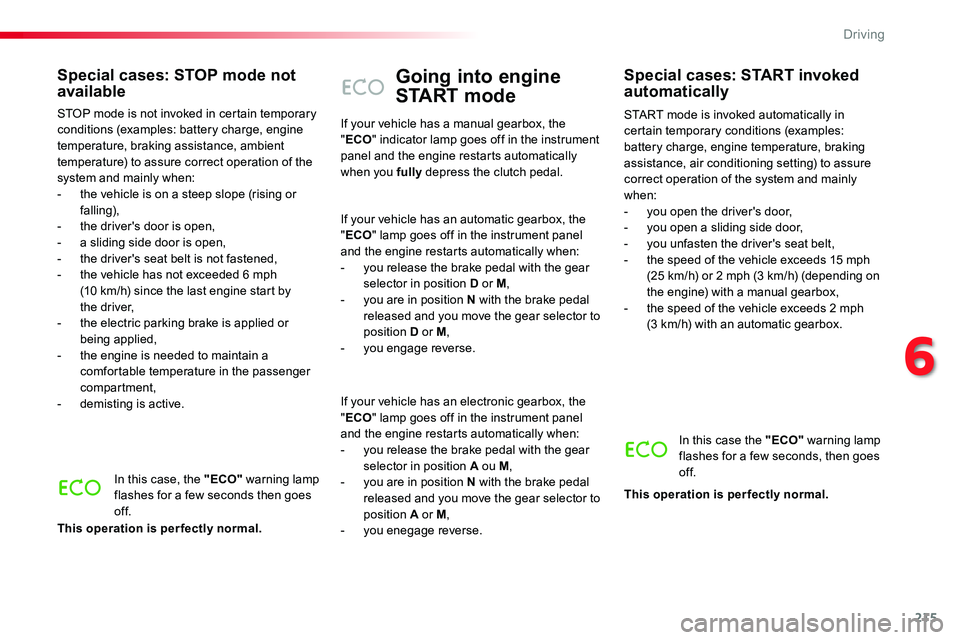
215
Going into engine
START mode
START mode is invoked automatically in certain temporary conditions (examples: battery charge, engine temperature, braking assistance, air conditioning setting) to assure correct operation of the system and mainly when:- you open the driver's door,
- you open a sliding side door,- you unfasten the driver's seat belt,- the speed of the vehicle exceeds 15 mph (25 km/h) or 2 mph (3 km/h) (depending on the engine) with a manual gearbox,- the speed of the vehicle exceeds 2 mph (3 km/h) with an automatic gearbox.
Special cases: START invoked automatically
In this case the "ECO" warning lamp flashes for a few seconds, then goes of f.
This operation is perfectly normal.
If your vehicle has a manual gearbox, the "ECO" indicator lamp goes off in the instrument panel and the engine restarts automatically when you fully depress the clutch pedal.
If your vehicle has an automatic gearbox, the "ECO" lamp goes off in the instrument panel and the engine restarts automatically when:- you release the brake pedal with the gear selector in position D or M,- you are in position N with the brake pedal released and you move the gear selector to position D or M,- you engage reverse.
If your vehicle has an electronic gearbox, the "ECO" lamp goes off in the instrument panel and the engine restarts automatically when:- you release the brake pedal with the gear selector in position A ou M,- you are in position N with the brake pedal released and you move the gear selector to position A or M,- you enegage reverse.
Special cases: STOP mode not available
STOP mode is not invoked in certain temporary conditions (examples: battery charge, engine temperature, braking assistance, ambient temperature) to assure correct operation of the system and mainly when:- the vehicle is on a steep slope (rising or falling),
- the driver's door is open,- a sliding side door is open,- the driver's seat belt is not fastened,- the vehicle has not exceeded 6 mph (10 km/h) since the last engine start by the driver,- the electric parking brake is applied or being applied,- the engine is needed to maintain a comfortable temperature in the passenger compartment,- demisting is active.
In this case, the "ECO" warning lamp flashes for a few seconds then goes of f.
This operation is perfectly normal.
6
Driving
Page 239 of 504
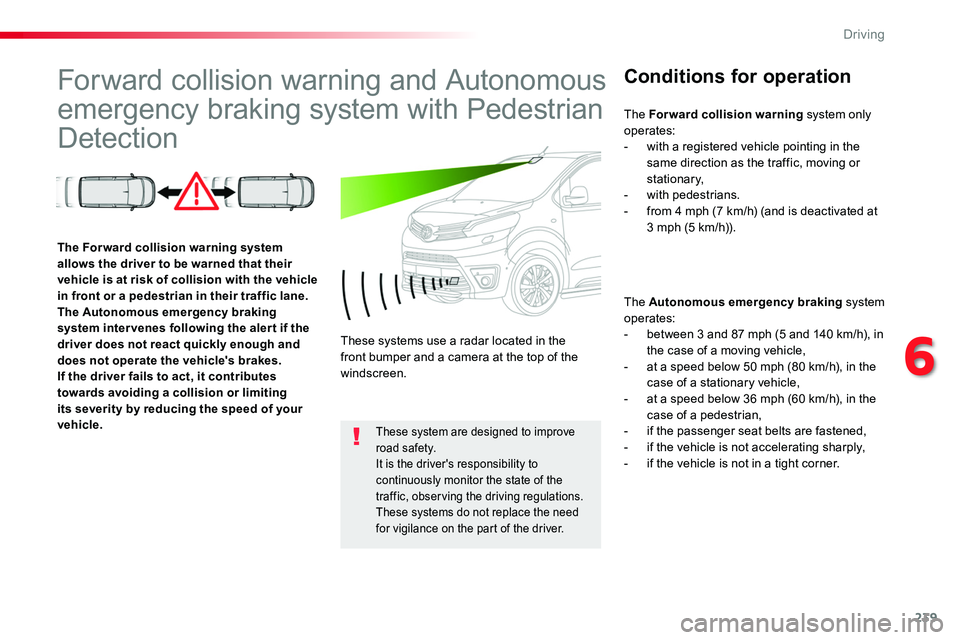
239
Forward collision warning and Autonomous
emergency braking system with Pedestrian
Detection
Conditions for operation
The Autonomous emergency braking system operates:- between 3 and 87 mph (5 and 140 km/h), in the case of a moving vehicle,- at a speed below 50 mph (80 km/h), in the case of a stationary vehicle,- at a speed below 36 mph (60 km/h), in the case of a pedestrian,- if the passenger seat belts are fastened,- if the vehicle is not accelerating sharply,- if the vehicle is not in a tight corner.
The Forward collision warning system allows the driver to be warned that their vehicle is at risk of collision with the vehicle in front or a pedestrian in their traffic lane.The Autonomous emergency braking system inter venes following the aler t if the driver does not react quickly enough and does not operate the vehicle's brakes.If the driver fails to act, it contributes towards avoiding a collision or limiting its severity by reducing the speed of your vehicle.
These systems use a radar located in the front bumper and a camera at the top of the windscreen.
These system are designed to improve road safety.It is the driver's responsibility to continuously monitor the state of the traffic, observing the driving regulations.These systems do not replace the need for vigilance on the part of the driver.
The Forward collision warning system only operates:- with a registered vehicle pointing in the same direction as the traffic, moving or stationary,- with pedestrians.- from 4 mph (7 km/h) (and is deactivated at 3 mph (5 km/h)).
6
Driving
Page 247 of 504
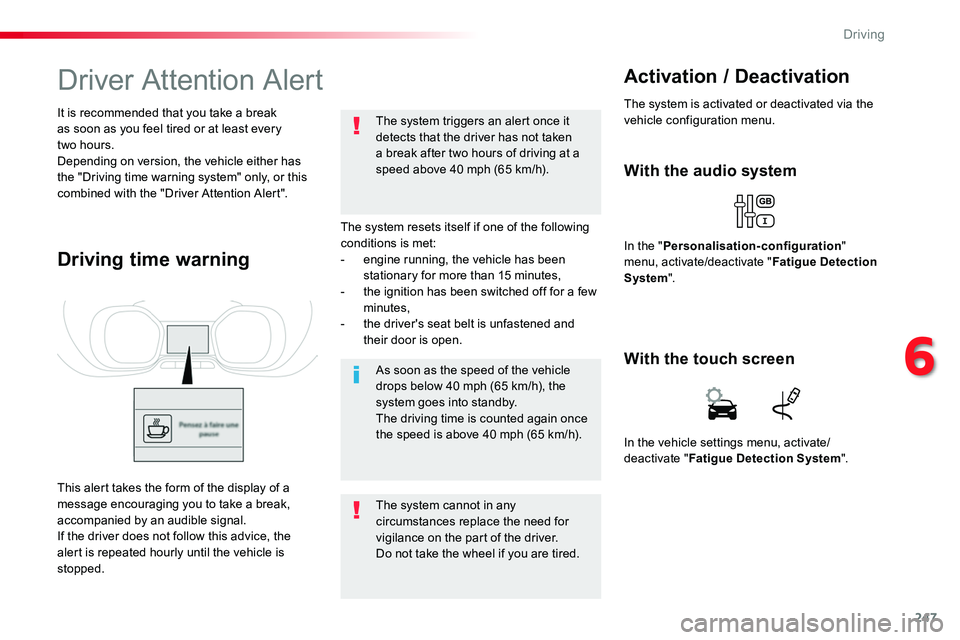
247
Driver Attention Alert
The system resets itself if one of the following conditions is met:- engine running, the vehicle has been stationary for more than 15 minutes,- the ignition has been switched off for a few minutes,- the driver's seat belt is unfastened and their door is open.
As soon as the speed of the vehicle drops below 40 mph (65 km/h), the system goes into standby.The driving time is counted again once the speed is above 40 mph (65 km/h).
The system cannot in any circumstances replace the need for vigilance on the part of the driver.Do not take the wheel if you are tired.
The system triggers an alert once it detects that the driver has not taken a break after two hours of driving at a speed above 40 mph (65 km/h).
It is recommended that you take a break as soon as you feel tired or at least every two hours.Depending on version, the vehicle either has the "Driving time warning system" only, or this combined with the "Driver Attention Alert".
Driving time warning
With the audio system
In the "Personalisation-configuration" menu, activate/deactivate "Fatigue Detection System".
Activation / Deactivation
The system is activated or deactivated via the vehicle configuration menu.
This alert takes the form of the display of a message encouraging you to take a break, accompanied by an audible signal.If the driver does not follow this advice, the alert is repeated hourly until the vehicle is stopped.
In the vehicle settings menu, activate/deactivate "Fatigue Detection System".
With the touch screen
6
Driving